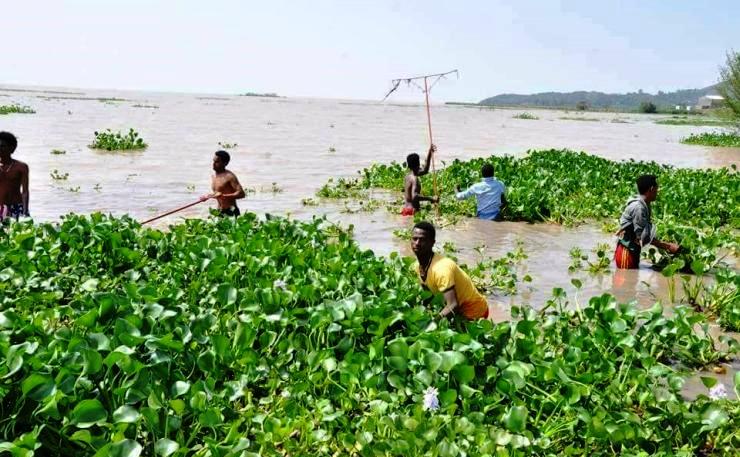
Induced by climate change, currently some invasive weeds have been threatening water bodies and ecosystems in various parts of the country. As a result, indigenous plant species are found on the verge of extinction.
In the 1970s the government imported an exogenous plant known as prosopis juliflora from Caribbean countries to curb the expansion of desertification and planted in Afar region. But the plant brought about a rather devastating impact by destroying indigenous plants. Grazing lands are also affected and forages of animals dwindled. Still now its expansion has unabatedly reached in the vicinity of Adama town.
The other invasive species, water hyacinth with its scientific name Eichhornia crassipes or locally known as “Enboch” appeared around 2011 on Lake Tana. It has been threatening the water and the water bodies. Since then the regional government with the collaboration of stakeholders tried to curb the impact brought by the invasive plant but the effort is in vein.
Chalachew Binalfew is a Pollution Supervision Expert with Amhara State Office of Lake Tana and other Water bodies Protection and Development Agency. As to him, Enboch (Water hyacinth) is the major invasive species which threatens the very existence of water bodies and expanding itself exponentially from time to time.
There is no research based information regarding the origin of the herb. But it was first spotted in the shores of Lake Tana in 2011.
Lake Tana is the habitat of various biodiversity. Hence, as the plant expands, it causes threat on the volume of the water, grazing lands at the bank of the lake and safety of aquatic animals of the lake.
Inhabitants of the lake shore are also affected since they have lost their source of drinking water and fishery. The pollution also discourages them from using the water both for human and animal drinking.
Because of the dwindling and retreating back of the water, practicing irrigation has become impossible these days.
The number of fish colony has also reduced. This intern negatively affected their livelihood. Naturally fishes conduct their reproduction in the edge of the water and females lay their egg and males release their gene there but due to the danger posed by invasive plant, the fertilization rate of fishes has dramatically reduced. Fishing also became a challenge. When fishers stretch their net to hunt fish from their boots, it is trapped by the “emboch” and makes their work very difficult.
Despite repeated attempts to measure and evaluate the invasive plant it was very difficult to find the exact amount due to change of weather.
By the year 2013/14 the regional authority attempted to measure the amount of the species by the scheme known as ground. The survey was conducted in a fragmented manner by woreda level experts residing in the nearby areas. The first information gathered by these experts was reported to senior officials.
Again on the second time the survey was carried out by the regional offices with the cooperation of other stake holders from universities, environmental protection authorities and experts from the Bahir Dar City branch of Ethiopian Biodiversity Institute. Though the study was conducted for three years with the support of GPS technology the result was not accurate. Yet the next measurement has shown a different result.
This happen because the reproduction of the invasive plant is fluctuating depends on the climate variation. During the months of August and September it is highly reproduced.
Months from February to May are the last mating seasons. Hence, unless subsequent mitigation measures are taken, the impact on the biodiversity will be immense.
The plant is characterized by changing its amount every month. The information gathered on the month of September with regard to the amount might be reduced by the month of February. The information gathered by different stake holders with in a year also varies.
The plant spreads to other places when there is a wind driven wave, particularly on the months of June and July. Some times when the amount of water reduces the amount of the plant also changes.
During the rainy season the amount again increases. On other time, the plant touches the floor of the lake through its root and invades an expansive water area. This makes understanding the exact amount of the plant very difficult unless information is gathered weekly or monthly.
According to Chalachew, the plant occurred for the first time in three woredas. Later on it expanded to seven woredas. It also appeared in ten kebeles and now it reached to 27 kebeles.
Currently the plant is found in the eastern part of Lake Tana and expanded to the bank of river Abay.
To date, various actions were taken to eradicate the plant. People deployed in the mitigation scheme tried to uproot the plant by diving in to the lake.
However, all their efforts are nullified as the small remnants of the plant are able to quickly reproduce themselves.
The polluted water of the lake has also caused infections and skin diseases on the youth as they swim deep inside it. This situation left them desperate and the matter still continued to be a head ache to the environment and the lake’s biodiversity.
Therefore, to bring about lasting solution stakeholders should redouble efforts in a coordinated manner.
The Ethiopian Herald Sunday Edition 14 /2020
BY ABEBE WOLDE GIORGIS





